The Chess Drum Beats in Africa!
On May 15th, I left Chicago’s O’Hare airport for a long journey to Africa. I finally set foot in Africa on May 18th in Johannesburg, South Africa. My trip was delayed two days because of a passport issue. I finally got my passport corrected, boarded my flight and flew a smooth 15 hours over the Atlantic Ocean, Namibia and Botswana.
I was amazed at the wide variety of movies on the entertainment system. I settled for “Blind Side”, “Fight” and Arabic language movie “Ameerika”. I landed at Oliver Tambo Airport in Johannesburg at around 5:20pm and a driver came to pick me up. World Cup fever was in full force as the airport was festooned with all types of paraphernalia of the pending football tournament.
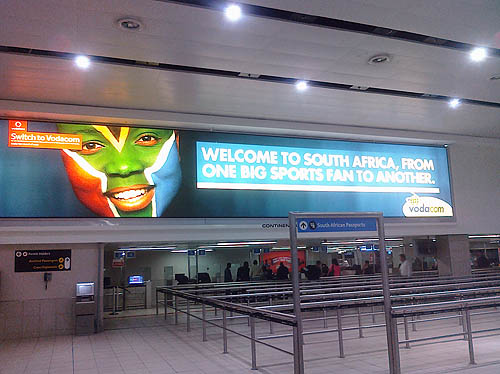
World Cup fever is everywhere in Africa!
After a 40-minute drive from the airport, I arrived at the Garden Court Hotel, a nice accommodation sitting across from the Nelson Mandela Court. Since I was delayed two days, my plans to meet with officials in CHESSA, the official federation of South Africa, fell through. I had informed Rista DeBeer of CHESSA that I would miss our scheduled meeting. I had intended on meeting International Master Watu Kobese, but it turns out he would be in Angola for BCI tournament. I did make contact with a Ph.D. classmate who has lived in South Africa for 12 years. That would be the only night I spend in the city.
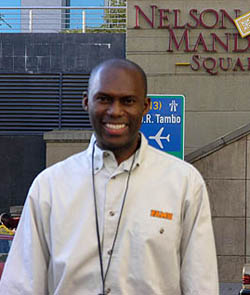
My group consisted of thirty professors from around the U.S. on a “Faculty development Tour”. They already had visits to Vodocom, Chamber of Commerce and the University of Pretoria. Before heading to Kenya, we visited Soweto, the Mandela Museum and the Apartheid Museum before catching the five-hour flight to Nairobi, Kenya.
Soweto is always a historic treasure to visit as there are many landmarks to commemorate the successful struggle against apartheid. This was my second time to South Africa and while I did not see the squatter camps this time, these landmarks are reminders that the struggle continues (a luta continua).
The flight to Nairobi was uneventful and we set down in Jomo Kenyatta International Airport at around 7:30pm. As we exited customs, we were met with a crush of people waiting for other travelers. After accounting for all 30 in our group, we boarded the vans and then set out on the dark roads of Nairobi. Artistically arranged billboards dotted the roads with the illuminated lights overhead. As a frequent traveler, I have learned not to spend time talking to fellow travelers instead of silently taking in the new scenery. Interesting view.
We arrived at the famous Stanley Hotel, reputed to one of the best accommodations in Nairobi. The lobby is one of the most important features of a hotel and the Stanley lived up to its billing. Prior to my trip I had posted messages on the Kenya Chess Forum and made contact with the chess players via e-mail. They stated that the hotel is in the middle of the commercial section and that I would be close to the chess club.
After a couple of grueling days visiting Kenyan businesses and traversing the streets of Nairobi, I arranged with some of the local players to visit the chess club. The days were very interesting as I was able to get an idea of the pace of Kenya. In one instance, I experienced the stifling Nairobi traffic. Once I got to the hotel it had begun to rain a bit. This means that traffic would intensify. There are so many potholes in Kenya that one has to be careful not to land in a water-filled crater. I finally made contact with the Kenya players and was picked up by Mehul Gohil and Kim Bhari during the rainy evening.
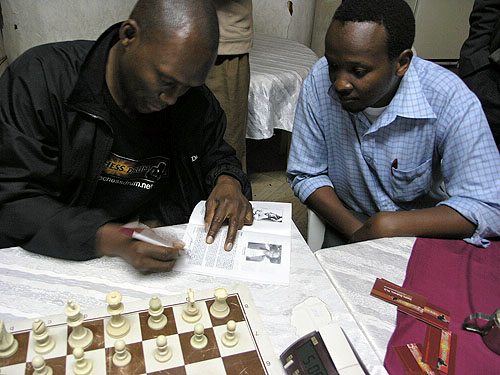
Daaim Shabazz signing a Wilbert Paige booklet for Githinji Hinga.
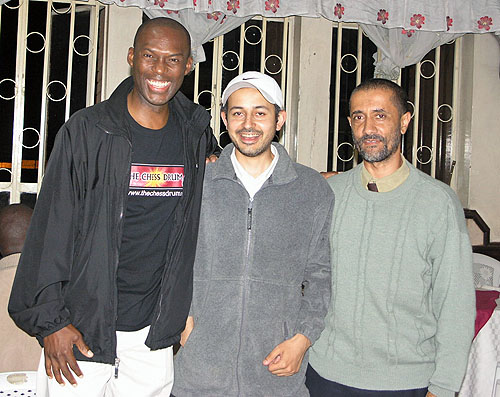
Daaim Shabazz with Mehul Gohil and Kim Bhari.
The club resided in an office building on the 2nd level and the room resembled a small lounging area. There were several tables arranged and there were players engaged in blitz battles. I presented club members with several copies of the Wilbert Paige Memorial booklet and dozens of monogrammed ink pens. After taking several pictures I played a round of blitz games with several players. The games were interesting apart from a few blunders and sluggish play on my part. I was well-received at the club and it was a wonderful evening.
On the next morning, we took a drive from Nairobi to Arusha, Tanzania. It was a tortuous road filled with massive potholes and in total disrepair. Our driver weaved as if he were navigating an obstacle course in a sports competition. Apart from the weaving and bobbing, the scenery was idyllic… beautiful plants and flowers, tropical trees, huge termite mounds and sights of the Maasai herding their cattle were common on the four-hour journey. There were stretches of the road that were paved with brand new black top. The Chinese have been making quite a bit of progress in improving the infrastructure and they could be seen on the road in their hard hats.
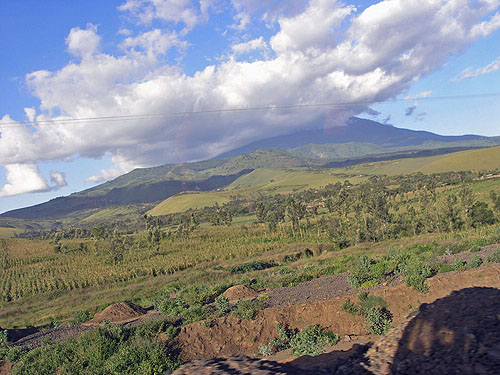
Idyllic view of mountains in Tanzania.
Arriving to Tanzania, we were shown Mount Kilimanjaro in the distance. It is a handsome structure that was partially covered by clouds on our Nairobi-Arusha drive, yet it yielded an imposing presence. We saw many of the beautiful man-made mud structures that are characterized in racist literature, but that are absolutely stunning and ingenious. We arrived in Arusha, but our hotel had a power outage on a few of the floors, so we have to change venue.
Tanzania is a country that shows a lot of character and not the typical commercialization that strips the cultural uniqueness. The streets were bustling and in the outskirts there were countless road markets. The country is very lush with all types of foliage, gardens on the roadsides and miles of coffee and corn plantations. In the city, there were hawkers everywhere and if you step out of the hotel, they were ready to sell you an array of overpriced souvenirs.
In one episode, one gentleman wanted to sell me a ski cap and and a bracelet for 55,000 shillings. Of course it is overpriced, but I told him I wanted the ski cap with the Tanzanian flag. He said 45,000 shillings. I asked him for a calculator and quickly showed him that the cap he was trying to sell me was about US$34.00. “That’s not a good price,” I told him. The same cap I can get for US$5.00 in the states. I eventually gave him 10,000 shillings (US$7.00) for it. The price haggling was good fun.
After spending the night in Arusha, we took a road trip to Ngorongoro. As we drove, the acacia trees were a staple in landscaping and children were seen fetching water and being industrious. There were also a number of schools off in the distance. The Maasai warriors were never too far out of view. We stopped for bathroom breaks, but many were urged not to photograph the locals unless permission was granted.
We finally arrived at the Ngorongoro Lodge which set on a coffee plantation. It couldn’t help to think about my coffee plant of 19 years. The official at the plantation gave us a complete tour and explained the processing from nurturing the trees to the fermentation, drying and roasting process. Another connoisseur came and invited us to sample the different blends. The whole experience gave me a new appreciation of coffee.
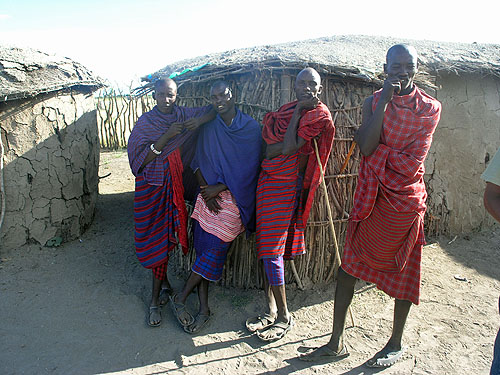
Young Maasai apprentices
The thing that I most remember about Tanzania is its greenery. There were plots of plants and flowers along the road for miles. Animals were grazing just short of cars and trucks whizzing past. We were sometimes stopped by a caravan of cows crossing the road. We visited a large coffee plantation and were given a tour of how coffee is produced from the tree to the roasting. We also visited a lush banana plantation which gave us an opportunity to understand why people in Africa sometimes live off US$1.00 a day.
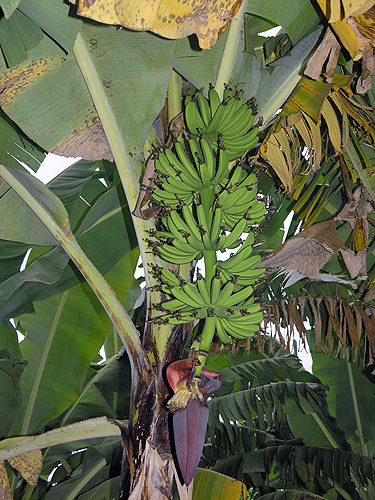
There were rows and rows of banana trees at different stages of development. We also ran into other fruits such as passion fruit, papayas, avocados and limes. There were also a pumpkin patch and a rice plantation. We got quite an extensive explanation of banana processing and how they were harvested. While I knew about the nine-month gestation period for bananas, I never knew how they sprouted and that they bore a pretty, purple bulbous flower at the end of the stem.
We visited a volcano crater, the home of a abundant array of wild animals. We saw wildlife in all its magnificence… wildebeest, zebras, warthogs, gazelles, bucks, elephants, lions, cheetahs and baboons. The most exciting part of the trip was at the end when we climbed 4,000 feet back up the crater on a precipitous slope of mud. We stopped once or twice to get a fantastic view of nature’s creation. However, there was nothing guarding us from a fatal tumble over the cliff. Nothing but a skillful driver. It was nerve-wrecking for some of the passengers as the wheels were only a few feet from the edge.

Stunning view of the crater!
On our second visit to an animal conservation, we saw a lot of giraffes and many of the animals mentioned. We rode by a colony of baboons and for about 10 minutes, we watched them socialize in their human-like ways. The giraffes were the most interesting and I was exposed to their “necking” ritual in which two males compete for a mate. On the third animal safari, we went on foot and came within 30 meters of animals. As we approached a herd of buffalo, they watched us closely for about 10 minutes. We were able to walk the trails of the animals and to see how they managed their habitat and co-existed. Fascinating!
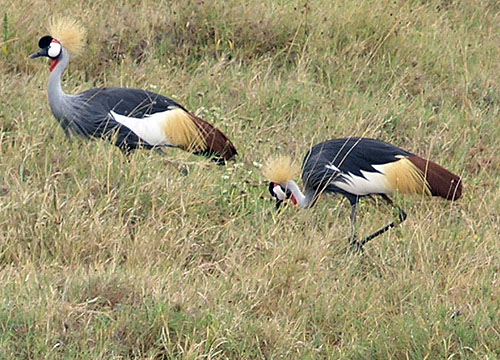
Crested Crane, national bird of Uganda
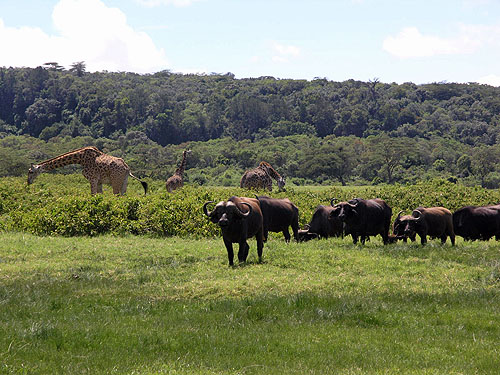
On the walking safari, we came face-to-face with the animals.

No introduction is needed here. By the way, this was a zoom shot. I was definitely not fifteen-feet away. 😐
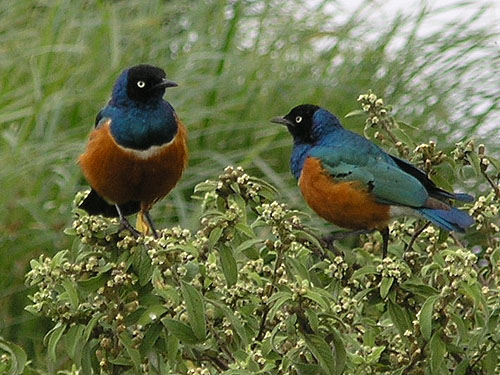
The handsome Superb Starling.
In this set of pictures to follow, I have chosen approximately 140 photos for this segment. The last set is dedicated to Tanzanian wildlife and nature. Links to all the pictures are also included if you’d like to take the time to view them. The total is close to 600. Enjoy!
All photos property of Daaim Shabazz.


Flight over the Namibia’s Kalihari Desert.
World Cup was on the mind of everyone.
Grand Court Hotel (Sandton, South Africa)
Michelangelo Towers with the adjacent Mandela Towers Mall
After a two day delay, I finally made it!
An interesting World Cup display.
World Cup fever is everywhere!
Example of acceptable graffiti.
Soweto natives working hard on daily chores.
Is there a jazz club nearby?
Rise up!
Kentucky Fried Chicken is popular fare in South Africa.
Vendors selling hand-made crafts. Very friendly!
Coca-Cola has a large presence in South Africa,
but in Tanzania, Pepsi appears to be for choice.
Me with an adorable girl from the Motsoaledi community. Her name is Ayana.
These are not nuclear silos!
Nelson Mandela Restaurant stands across from the Mandela museum.
The museum was once the home of the revolutionary.
Me standing in front of the Apartheid Museum. It is a museum with a wealth of information and takes a half day to go through the literature and movies.
There were two entrance ways to the museum: Blacks Only and Europeans Only.
South African children arriving to visit the Apartheid Museum… or was it the amusement park across the street?
https://www.facebook.com/album.php?aid=170333&id=513866269&l=e8ae3874a9
Welcome to Kenya!
The Stanley Hotel
Bright and colors billboards! The designs are always happy and exhibiting some type of family values.
Entrance to the Elephant orphanage. These elephants are rescused from poachers which is a major problem in Kenya. Wildlife is a natural treasure and its protection to tourism is vital.
Elephants are very social animals and smart!
Flowers from the ubiquitous acacia tree
This is the home of Karen Blixen House. Blixen wrote ‘Out of Africa’ on which a famous movie was made about her quest of protecting wildlife in Kenya.
Impoverished conditions are apparent as we approach the Kibera slums.
Life goes on at a moderate pace here.
Kenyan boys enjoying the moments they will remember later on.
Men chatting about the daily news. Habari gani?
Our guide in the Kibera slums was Freddy and Charles. Two young men who lived in the community. The Kibera tour is actually a bit controversial because it exposes the worst aspects of Kenya. The site is kiberatours.com.
Me with one of the guide’s mother. Her name is Jael and she welcomed us into their home.
Unpaved roads on a rainy days means that we will trudge in mud throughout the tour. Hakuna matata.
Lady selling coal, the main fuel source in the community.
These are artisans making beautiful crafts… from animal bones.
Poverty comes in some many different languages.
While the place was woefully impoverished and garbage strewn about, you can see that life took on normalcy as people were industrious and carrying on about their lives. Boys had a football match in the background.
Water and sewer management. Kiberi residents can use the toilet facilities here and also bathe.
🙂
🙂
Fierce game of draughts.
🙂
Barack Obama’s imagery was ubiquitous.
This was an orphanage inside the Kibera community. The billboard encourages sexual responsiblity!
The rough translation of this Swahili sign is Do not use the bathroom here unless you are a cow!
Me with the tour guides at Kibera.
Another day in Kenya. People (regardless of gender) greet with a friendly handshake.
This was an artistic arrangements of gourds at the Kenyan National Museum.
Entrance to the Coca-Cola distribution office. Very impressive operation that has 90% of the soft drink market in Kenya.
Now THIS is what I call a pothole!
Young man was on the roadside washing in the water.
Me with members of the Kenyan Chess Federation
Mosque in downtown Nairobi which I visited.
KENYA
Set #1: (46 photos) https://www.facebook.com/album.php?aid=170953&id=513866269&l=7ab15696d6
Set #2: (57 photos) https://www.facebook.com/album.php?aid=171116&id=513866269&l=f0853d279a
Set #3: (51 photos) https://www.facebook.com/album.php?aid=170961&id=513866269&l=e0c7f36d72
Set #4: (7 photos) https://www.facebook.com/album.php?aid=171644&id=513866269&l=3178bcb5de
Set #5: (23 photos) https://www.facebook.com/album.php?aid=172138&id=513866269&l=43b94d68ca
Kenya-Tanzania: (25 photos) https://www.facebook.com/album.php?aid=172146&id=513866269&l=860895e13d
Here we see new roads being laid down. There is a Chinese in the white hat. They have been instrumental in the improvement of infrastructure throughout the continent. After riding from Nairobi to Arusha, it is hard to believe that people could actually drive that route safely. We were told that the roads had no blacktop the previous year.
Certainly a place you would not want to build a wooden house next to. This is a large termite mound. Yes… I saw some three times this size.
Driving toward the Tanzanian border we see a herd of goats by the roadside. This is Maasai land.
Water is always an issue in developing countries.
The most beautiful flower tree I’ve seen to date.
We are here… Tanzania!
In Tanzania, we see the Cultural Center.
A common means of transport in Africa. Women are able to tote large bundles on their heads and walk for miles.
Here I’m inside of a company that produces mosquito nets. It is a very intricate process and quite fascinating. The nets are treated with an insecticide.
I’m not a coffee drinker, but I love the plants. Here is one with some ripe coffee “cherries”.
Finished product… so many different varieties and blends.
Not sure what this plant is called, but it is beautiful!
Freedom Torch
Rice for sale!
I’m not sure if these girls were related or just good friends, but they hugged as they walked for a long distance.
This stork is airing out his wings.
This boy was very amused at his image on the digital cameras.
We were getting a lecture on the ways Maasais used plants to create concoctions of medicinal value.
A young banana plant with a purple flower. This plant has just developed the banana fruit over several months. When the purple flower drops, the banana is ready to pick.
Houses made with natural materials… mud, banana fronds, twine and branches.
Rice
This pond is using for swimming. The water was very clean.
The meal was prepared by a Maasai woman who lived in this plantation and had a house with solar panels. She made a most delicious meal!!
These were a few of the items made in our meal. The table was a LOT longer. In front you have eggplant, cabbage, spinach and in the back there was a stew, beef rice, corn on the cob and cooked bananas. There was also fresh cucumber/tomato salad, avocados, red bananas, lentils and flat breads.
Papaya tree next to a banana tree (upper left).
We stopped at an art gallery to see some very beautiful paintings… and many of us purchased one or more pieces.
This was one of the fascinating scenes of my trip. As we boarded the bus to leave the Maasai village and banana plantation. We heard loud chanting increasing in a loud crescendo. It was school children on a Friday leaving school. There were hundreds of them chanting songs in Swahili and led a powerful procession down the street. It was amazing!
Young Maasai warriors. We visited their village and even got a chance to go inside of one of the home. They are made of cow dung and branches… solid structures. The red clothes represent a royal tradition that has been unbroken for perhaps centuries.
Regal-looking Maasai woman
TANZANIA
Tanzania #1: http://www.facebook.com/album.php?aid=172150&id=513866269&l=d44e94d8e2
Tanzania #2: http://www.facebook.com/album.php?aid=172536&id=513866269&l=8465c35d1d
Tanzania #3: http://www.facebook.com/album.php?aid=172935&id=513866269&l=2f79a998cb
Tanzania #4: http://www.facebook.com/album.php?aid=172942&id=513866269&l=62037105bd
Tanzania #5: http://www.facebook.com/album.php?aid=172987&id=513866269&l=7b433b36c9
Pictures of wildlife… next!!!
Truly amazing!!!
The Wildebeest. An animal with very advanced herding instincts. Very powerful and territorial, but possess poor eyesight. Wildebeest will help one of its kind if it is in trouble and attempt to gore a predator, sometimes inflicting a fatal or debilitating stab.
The Thomson gazelle. This gracefully beautiful animal can reach high speed and can outsmart a faster cheetah by making pinpoint turns and by its stamina. It can reach speeds of 40 mph by fully extending its body (as if flying) between strides.
A couple of gazelles taking in the fresh breeze.
Zebras eating amongst family and the wildebeest. Zebras and wildebeest are best friends. They complement each other and are not competitive grazers. They like different parts of the same grass. Zebra have keen vision while wildebeest have poor vision. Wildebeest are larger in numbers and are typically better fighters.
Wildebeest amongst his feathery friends. Birds often follow large animals in order to feed off of the bugs that constantly pester them. Another example of symbiotic relationship of nature.
Blacksmith… very handsome bird.
Hippo by the marsh. You can seen the flamingos in the background and a blacksmith on the right.
Flock of ostriches
These lions were the star of the show. Lines of trucks had stopped to view these brothers. They were both injured and bleeding from either scratches from branches or in a skirmish with prey.
Uganda’s national bird, the crested crane.
A submerged hippopotamus amongst a family of acacia trees. The large animal does this to cool off, not to hide from prey.
Superb Starlings
Breathtaking scenery!
A view from the top of the crater… it is a 4,000 foot drop to the bottom.
Baboon navigating around the livery truck.
This was an interesting tree that resembles a live figure.
The vervet is a socialable primate and appears to be posing for these photos.
Buffalo with his white feathery friend going along on a ride!
Baboon grooming her offspring.
This termite mound was about seven-feet tall.
The spotted barbet is one of the most unique birds!
The lovable elephant… one of the big five
(elephant, rhinoceros, lion, leopard, buffalo)
Nice hornbill birds… a baboon was not far behind. The baboon knows these birds follow big animals like elephant because of the bugs they attract. The dung left behind are infested with dung beetles with the baboons feed off of.
Daaim with a herd of buffalo in the background.
Nature at its finest.
Herd of Waterbucks
Guinea Fowls
Dik-Dik, the world’s smallest antelope.
Hope you enjoyed the photos! 🙂
TANZANIA
Set #3: (53 photos) https://www.facebook.com/album.php?aid=172935&id=513866269&l=2f79a998cb
Set #4: (76 photos) https://www.facebook.com/album.php?aid=172942&id=513866269&l=62037105bd
Set #5: (88 photos) https://www.facebook.com/album.php?aid=172987&id=513866269&l=7b433b36c9
Astonishing report!!!!!!!
SCENES AROUND NAIROBI, KENYA
Downtown Nairobi
Nairobi is a bustling city of three million.
This is the memorial wall erected at the site of the bombing attacks at the U.S. Embassies in Kenya and Tanzania in 1998. It is now called “Memorial Peace Museum”. It contains some fascinating photos from the event with commentary of some of the survivors. There was a video as part of the tour detailing the bombing. This included the security guards’ interaction with the two persons driving the truck with explosives.
This is the office building adjacent to the Embassy. It survivied the impact, but did suffer fire damage.
SCENES AROUND TANZANIA
One of the lodging facilities at the Ngorongoro State Lodge in Tanzania.
Beautiful landscaping!
The likable vervet… I had to include a second photo. This was taken at Arusha National Park.
There are so many of these sites in Africa. Natural scenes have their own inherent beauty. This was taken at Manyara National Park.
Square in downtown of Arusha
THE KIBA PALACE (ARUSHA, TANZANIA)
Notice something interesting about the picture? My vehicle and the vehicle on the left were going in the same direction. In Tanzania, they drive on the left-hand side. You can see why we are driving on the wrong side. 🙂
Daaim, What can I say…I love it !!! You did a great… Big Hug !!!
Sofia
Hi Sofia,
I have some pictures from your birthday party and the video. It was great. Here is the video. The chess community that visits here will appreciate this! 🙂
Daaim –
Thanks for posting these. No wonder you seemed so serious about your photography–you have some beautiful shots. I enjoyed our discussions, although they were too brief. Hope we can continue them some time.
Jack C
Daaim,
Thank you for the video !!! great memories… I love this page…
You did a wonderful job…
Keep in touch..
Love
Sofia
Daaim,
Great pictures and narrative! Thanks so much for posting this. Love the videos, too!
Jacqueline
@ Jack… Thanks for the pic of me with the buffalo in the background. I really enjoyed that walking tour. It is great to feel so close to the animals and not estranged like in a truck or even worse, a zoo. Of course, I don’t mind being estranged from hyenas and lions.
@Sofia… You were a joy on the trip. I enjoyed the outing in Tanzania when we met the street merchants. I hope you like the video! I’m actually up in the Philly area once a year for chess. However, this year we’ll be outside of the city.
@Jacqueline… Thanks. This is a chess website, but it provides many viewers with insight on how beautiful and intriguing Africa really is. We see so many horror stories in western media. I was sorry I miss the visit to the University of Pretoria. That’s what I would have done differently… interacting with university students in Kenya and Tanzania. I did this in Ghana and it was such a great experience.
Hi Daaim, Thanks for sharing your beautiful photos and commentary. your pictures are amazing. It was really fun traveling with you. Best wishes, Susan
Susan,
It was a good trip and it appears that we went at exactly the right time of the year.
Great collection Daaim!
I am so blessed to have met such wonderful individuals. Glad you captured such wonderful memories and your kindness to share with us–plus the blog! THANK YOU!!
Your pics are the first ones that I’ve seen –really great. Just came back last week and plunged into two summer courses Mon-Frid so I am just starting to get oriented.
Stay blessed Bro and lets keep in touch.
Hi Daaim,
That you are a great photographer is all i can say. I love those pics.
Thanks and God bless!
Jane.
I never knew how beautiful Tanzania was until these pics. Good job ! I hope chess continue to grows in Africa 🙂
Great job! Only a heart full of love and an eye full of joy could capture this land in such a wonderful way. This is very special in the way you captured and shared a misunderstood land and much misaligned people. Your effort is greatly appreciated. Just felt like I went on a free journey back home! I hope many others outside of this chess site get to experience this land and it’s people an you are bless for sharing your experience.